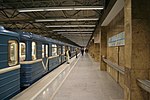Zvyozdnaya
1972 establishments in the Soviet UnionRailway stations in Russia opened in 1972Railway stations located underground in RussiaRussian railway station stubsRussian rapid transit stubs ... and 1 more
Saint Petersburg Metro stations

Zvyozdnaya (Russian: Звёздная) is a station on the Moskovsko-Petrogradskaya Line of the Saint Petersburg Metro. It was opened on December 25, 1972. It was designed by K.N. Afonskya, A.C. Getskin and V.P. Shuvalova. In the original blueprints, the station was called "Imeni Lensoveta" (Soviet of Leningrad Honorary station).
Excerpt from the Wikipedia article Zvyozdnaya (License: CC BY-SA 3.0, Authors, Images).Zvyozdnaya
Звёздная улица, Saint Petersburg Srednaya Rogatka (округ Звёздное)
Geographical coordinates (GPS) Address Nearby Places Show on map
Geographical coordinates (GPS)
| Latitude | Longitude |
|---|---|
| N 59.833233333333 ° | E 30.349491666667 ° |
Address
Звёздная улица 3 к1
198142 Saint Petersburg, Srednaya Rogatka (округ Звёздное)
Saint Petersburg, Russia
Open on Google Maps







